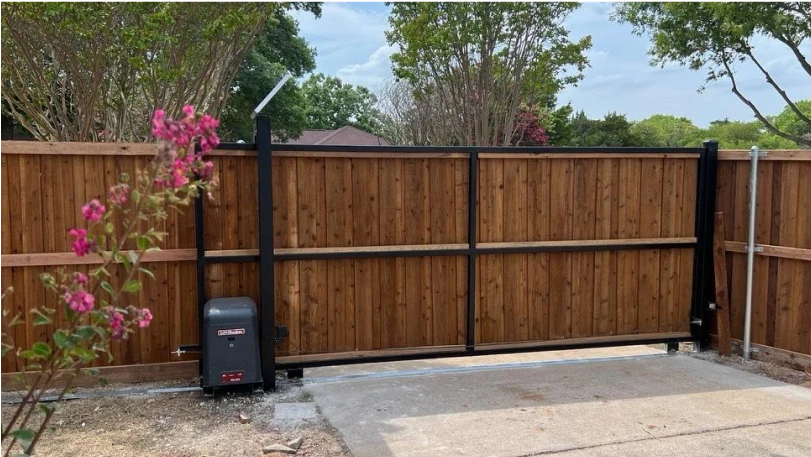If you’ve lived in North Texas long enough, you already know our weather has a mind of its own. One day it’s a calm breeze and sunshine, and the next it’s sideways rain, 50 mph gusts, and a thunderstorm that makes you question your life choices.
And while we may not take a direct hit from hurricanes, those leftover systems and summer storms that sweep across DFW can still do plenty of damage. Fences take a beating — wind, rain, heat, and even soil movement all work together to weaken them over time.
That’s why building a storm-resistant fence isn’t just about looks — it’s about keeping it standing straight when the weather turns ugly. Here’s how to make sure your fence can handle whatever Texas throws at it.
Texas Weather: A Fence’s Biggest Test
Let’s be honest: Texas weather doesn’t make anything easy. We’ve got clay soil that shifts when it gets wet, scorching summer heat that dries wood out, and storms that roll through with wind gusts strong enough to send lawn chairs down the block.
All of that takes a toll on a fence.
- Heavy rain loosens the soil around posts.
- Strong winds push against panels like sails.
- The hot sun warps and cracks wood over time.
- And freezing temps (on the rare occasions we get them) expand moisture inside the wood, making it split.
If your fence isn’t built for this kind of punishment, it won’t last long. That’s where a few smart building choices can make all the difference.
Step 1: Start with Strong Posts
Your fence posts are the backbone of the entire structure. If they’re weak, shallow, or starting to rot, the rest of the fence doesn’t stand a chance.
Here’s the rule of thumb: a storm-resistant fence starts underground.
In other words, if you want your fence to stay upright, it needs deep, solid posts.
- Use steel posts whenever possible. Wood posts can rot, twist, and snap under stress, but steel is built to last. Most DFW cities — like Mansfield — even require 2 ⅜-inch galvanized steel posts for new wood fences with a max height of 8 feet. They know what works here.
- Set your posts deep. A good depth is at least one-third the height of your fence. So if your fence is 6 feet tall, your posts should go about 2 feet deep — minimum. In high-wind areas or open lots, 30 inches is even better.
- Anchor them in concrete. Pour concrete around each post, and make sure the concrete rises a couple inches above ground level so water drains away instead of pooling around the base.
- Add gravel below the concrete. This helps with drainage and prevents frost heave or soil expansion from lifting your posts over time.
If you’re investing in a new fence, ask your builder about the post specs. At M&C Fence, we never cut corners — our posts are set deep, straight, and solid so your fence doesn’t start leaning after the first big storm.
Step 2: Pick a Design That Lets Wind Pass Through
The tighter the fence panels, the more wind they catch. A solid fence might look great, but when that gust hits at 40 mph, it acts like a sail — putting huge pressure on each post.
In wide-open areas (or if you’ve got a backyard that gets strong crosswinds), consider designs that let a little air flow through.
Some good options:
- Shadowbox fencing: Boards are staggered on both sides of the rail, creating privacy without trapping wind.
- Board-on-board: Similar to a shadowbox, but with boards overlapping slightly instead of spaced apart.
- Shorter fence heights: In especially windy areas, going a foot shorter can make a big difference in stability.
- Extra bracing in corners and gates: Reinforcing those stress points helps everything stay aligned.
You don’t have to sacrifice looks for durability — you just need a design that’s smarter about how it handles wind.
Step 3: Choose Materials That Can Handle Texas
Not all fence materials are created equal. What works in one climate might fall apart here. When it comes to DFW, here’s what to keep in mind:
- Cedar wood is king. It’s naturally weather-resistant and won’t warp or rot as quickly as pine. It also looks great, whether you stain it or let it weather naturally.
- Galvanized steel offers unmatched strength for posts and frames. Powder-coated steel even resists rust, so it keeps its clean look for years.
- Vinyl can be a good low-maintenance option, but Texas heat can make it brittle over time — especially on south-facing fences that get all-day sun.
- Aluminum or wrought iron fences are incredibly durable, though they’re more for decorative or security purposes than privacy.
If you’re not sure what’s best for your yard, think about your goals. Want low maintenance? Go metal or composite. Want natural beauty and full privacy? Stick with cedar — just make sure it’s built right.
Step 4: Don’t Forget the Drainage
Most people don’t think about drainage when they’re planning a fence — until the bottom of it starts rotting. Standing water and clay soil are a bad combo.
If water pools around your posts, it can eat away at the wood (or even the concrete base) over time. That’s why good drainage is part of storm-proofing.
Here’s what helps:
- Slope your yard slightly away from the fence line. Even a 2% slope is enough to move water off.
- Add a French drain (a gravel trench with a perforated pipe) if you have an area that tends to collect runoff.
- Use crushed stone or decomposed granite at the base of posts — it drains better than packed soil.
- Keep sprinklers from hitting the fence directly. Constant moisture weakens both wood and metal hardware.
- Don’t pile mulch against the bottom rails. It traps water and encourages rot.
Good drainage design doesn’t have to be complicated, but it’ll add years to your fence’s life.
Step 5: Use Quality Hardware (and the Right Kind)
A lot of fence failures start at the fasteners — the little parts most people never think about. Screws, nails, hinges, and brackets take the brunt of vibration and movement during storms, and if they’re cheap or rusted, they’ll eventually fail.
- Galvanized or stainless-steel screws hold tighter and resist corrosion much better than nails.
- Ring-shank nails are fine for smaller sections, but screws generally perform better in Texas’ weather swings.
- Heavy-duty gate hardware (like wind-rated hinges and steel drop rods set in concrete) can keep your gates from twisting or blowing open in storms.
- Diagonal bracing in gate frames keeps them from sagging over time.
At M&C, we treat hardware like structure, not decoration. Everything is anchored, reinforced, and rated for outdoor exposure — because when a storm hits, every screw counts.
Step 6: Keep Trees and Landscaping in Check
You can build the strongest fence in the world, but if a tree branch falls on it, it’s done.
Before storm season, take a walk around your yard and look for anything that could threaten your fence:
- Overhanging branches that could snap during high winds.
- Trees with roots growing toward your fence line.
- Dead or leaning trees that look unstable.
Keep a 10-foot buffer between large trees and your fence whenever possible. Trim branches regularly, and if you notice any trees looking sick or hollow, have an arborist check them out. Preventive trimming costs a lot less than rebuilding half your fence after a storm.
Step 7: Inspect After Every Big Storm
After the rain clears, give your fence a quick checkup. It doesn’t take long, but it can save you from major repairs later.
Here’s what to look for:
- Posts that look loose or leaning.
- Cracked or shifted concrete bases.
- Missing screws or loose pickets.
- Rusted hardware or hinges that don’t close right.
- Mud or standing water pooled around posts.
If you spot something small, tighten or patch it before it gets worse. If you see bigger issues (like movement in the posts or structural leaning), it might be time to call in the pros.
Take photos, too. This will help if you ever need to file an insurance claim for storm damage.
Step 8: Schedule Regular Maintenance
Even a well-built fence needs a little attention now and then. Regular maintenance is your key to keeping it storm-ready year after year.
- Clean off dirt and debris every few months — it prevents buildup that traps moisture.
- Re-stain or seal wood fences every 2–3 years to protect against sun and rain damage.
- Lubricate hinges and latches to prevent rust.
- Tighten hardware once or twice a year, especially after strong winds.
- Keep plants trimmed back from the fence so they don’t rub or hold moisture against it.
Think of it like car maintenance — a little care here and there goes a long way toward avoiding costly repairs.
Step 9: Know When to Call a Professional
Some storm damage can be DIY’d — tightening screws, cleaning, or resealing wood. But when you’ve got leaning sections, shifting posts, or cracked concrete footings, it’s best to let an expert take a look.
A professional fence company (like M&C) can assess what’s still structurally sound and what needs reinforcement or replacement. We know how local soil reacts to weather changes, what the city codes require, and which materials hold up best in DFW’s mix of heat and storms.
Even better — we can often repair or reinforce parts of your fence so you don’t have to rebuild the whole thing.
Step 10: Protect Your Investment
A strong fence doesn’t just look good — it protects your home’s value, your privacy, and your safety.
If you’re building new, make sure your contractor:
- Uses steel posts set deep in concrete.
- Chooses high-quality cedar or composite pickets.
- Designs for wind resistance with bracing or airflow.
- Installs drainage solutions where needed.
- Uses galvanized fasteners and heavy-duty gate hardware.
- Builds to code (and then some) — just like we do at M&C.
If you already have a fence, now’s a great time to give it a tune-up before storm season hits full swing. Reinforce weak spots, trim nearby trees, and make sure drainage is doing its job.
Because once those summer storms start rolling in, you’ll be glad you did.
M&C Fence Can Help You With All Parts
Here in North Texas, the weather’s unpredictable — but your fence doesn’t have to be.
When it’s built the right way, with solid materials, proper depth, and smart design, it can handle years of wind, rain, and sun without leaning or cracking. At M&C Fence, we’ve been helping homeowners all over the DFW area build fences that last — fences that look great on day one and still stand tall after every storm season.
So whether you’re replacing an old fence, building new, or just reinforcing what you’ve got, remember: a strong fence isn’t just about looks — it’s about peace of mind.
Give us a call or send us a message today for a free quote. We’ll take a look at your property, talk through your options, and help you build a fence that’s ready for whatever Texas weather brings next.


